Landscape Architecture Theory Report: Cayuga Medical Center Analysis
VerifiedAdded on 2022/12/22
|14
|2693
|73
Report
AI Summary
This report provides an in-depth analysis of the landscape architecture at Cayuga Medical Center, focusing on the integration of sustainable design principles. The study examines the master plan's emphasis on enhancing site circulation, developing a healing environment, and improving stormwater management. Key elements include the implementation of bio-retention basins, porous pavements, and strategies to reduce impervious surfaces. The report highlights the creation of green spaces, such as restorative and cafeteria gardens, designed to enhance patient and staff well-being. Furthermore, the report explores the consolidation of parking, alternative transportation options, and the overall commitment to creating a campus that harmonizes with nature. The design team's holistic approach aimed to integrate sustainable practices into the facility's expansion and renovation projects. The report highlights how the Cayuga Medical Center has successfully incorporated sustainable landscape architecture principles and improved the overall environment.
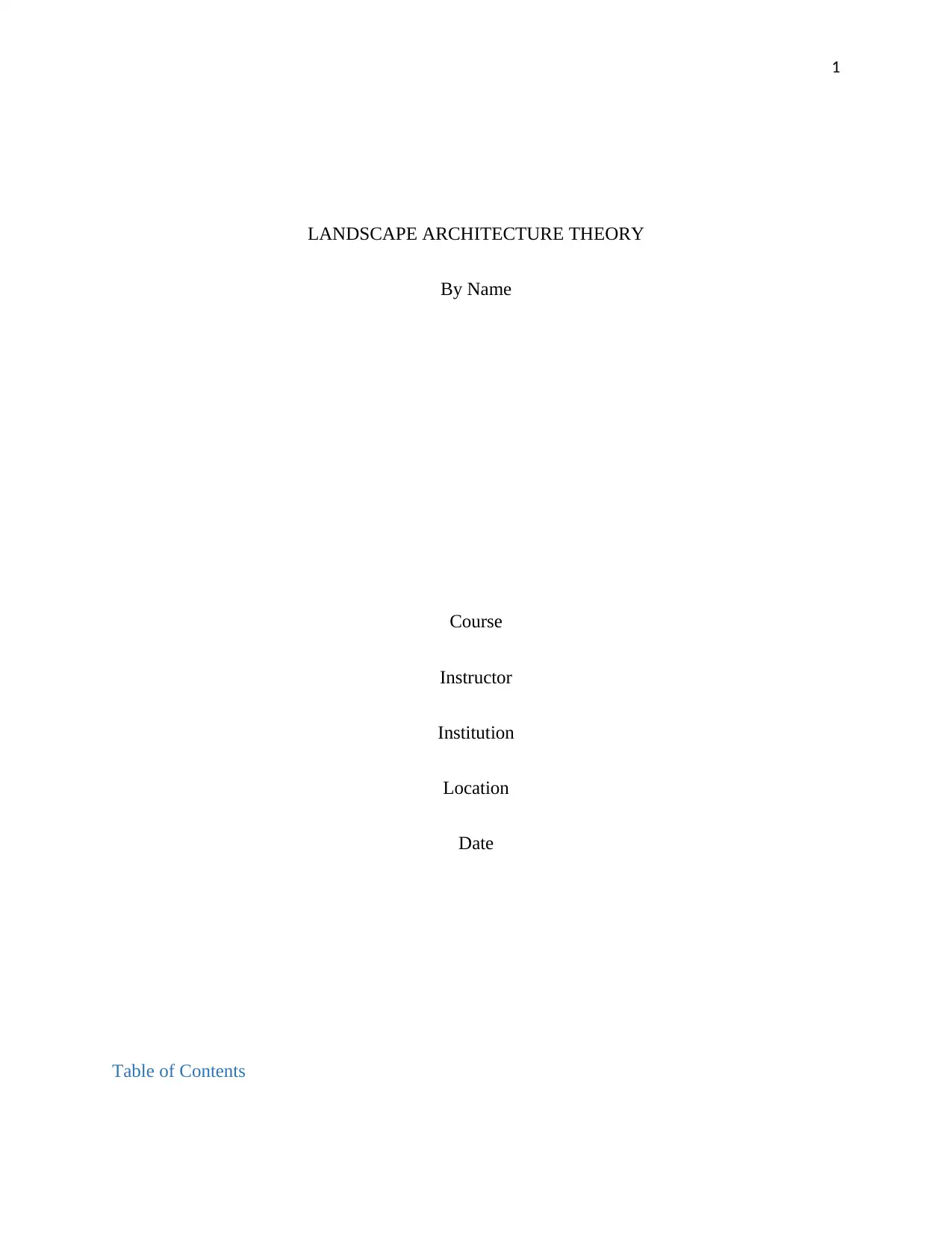
1
LANDSCAPE ARCHITECTURE THEORY
By Name
Course
Instructor
Institution
Location
Date
Table of Contents
LANDSCAPE ARCHITECTURE THEORY
By Name
Course
Instructor
Institution
Location
Date
Table of Contents
Paraphrase This Document
Need a fresh take? Get an instant paraphrase of this document with our AI Paraphraser
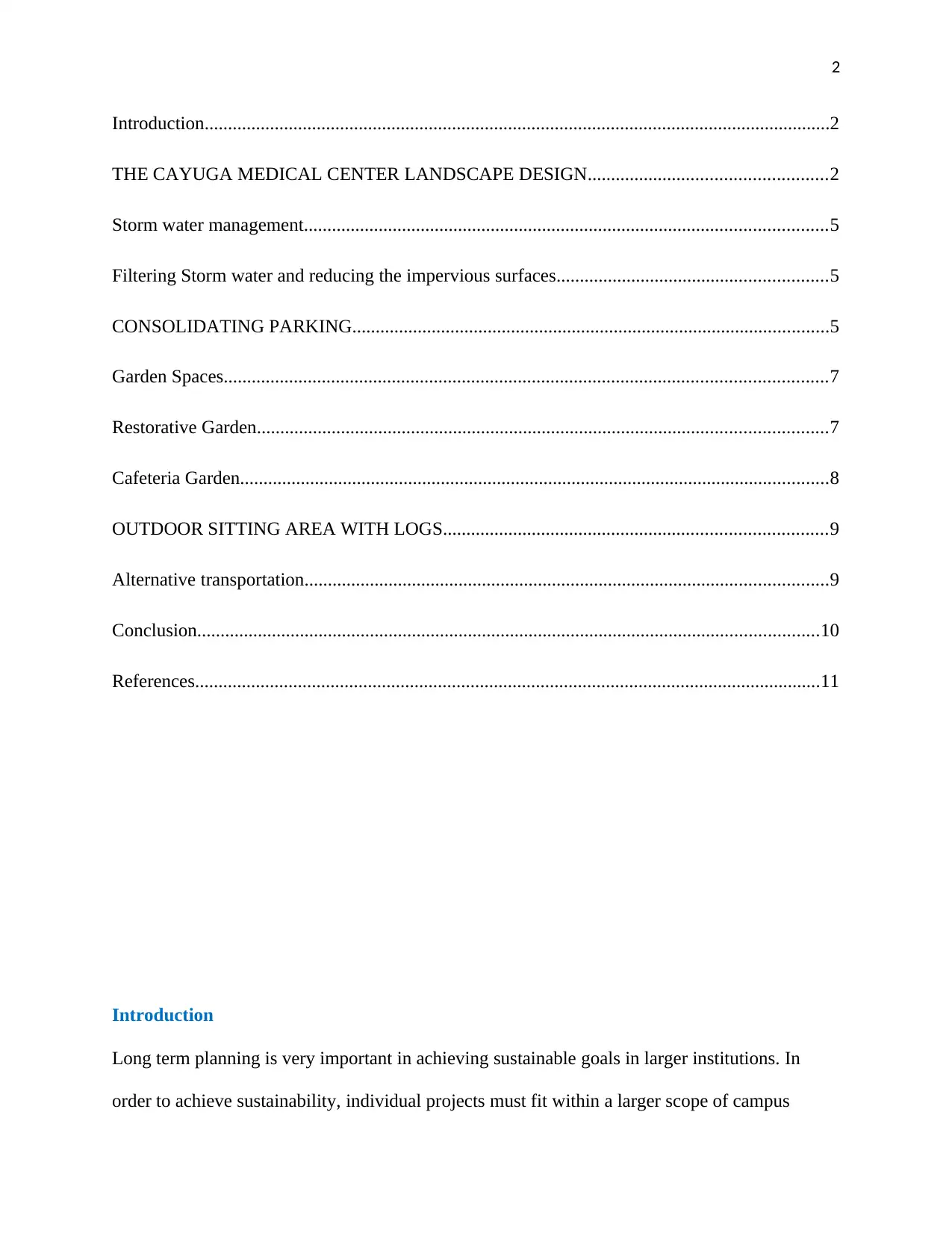
2
Introduction......................................................................................................................................2
THE CAYUGA MEDICAL CENTER LANDSCAPE DESIGN...................................................2
Storm water management................................................................................................................5
Filtering Storm water and reducing the impervious surfaces..........................................................5
CONSOLIDATING PARKING......................................................................................................5
Garden Spaces.................................................................................................................................7
Restorative Garden..........................................................................................................................7
Cafeteria Garden..............................................................................................................................8
OUTDOOR SITTING AREA WITH LOGS..................................................................................9
Alternative transportation................................................................................................................9
Conclusion.....................................................................................................................................10
References......................................................................................................................................11
Introduction
Long term planning is very important in achieving sustainable goals in larger institutions. In
order to achieve sustainability, individual projects must fit within a larger scope of campus
Introduction......................................................................................................................................2
THE CAYUGA MEDICAL CENTER LANDSCAPE DESIGN...................................................2
Storm water management................................................................................................................5
Filtering Storm water and reducing the impervious surfaces..........................................................5
CONSOLIDATING PARKING......................................................................................................5
Garden Spaces.................................................................................................................................7
Restorative Garden..........................................................................................................................7
Cafeteria Garden..............................................................................................................................8
OUTDOOR SITTING AREA WITH LOGS..................................................................................9
Alternative transportation................................................................................................................9
Conclusion.....................................................................................................................................10
References......................................................................................................................................11
Introduction
Long term planning is very important in achieving sustainable goals in larger institutions. In
order to achieve sustainability, individual projects must fit within a larger scope of campus
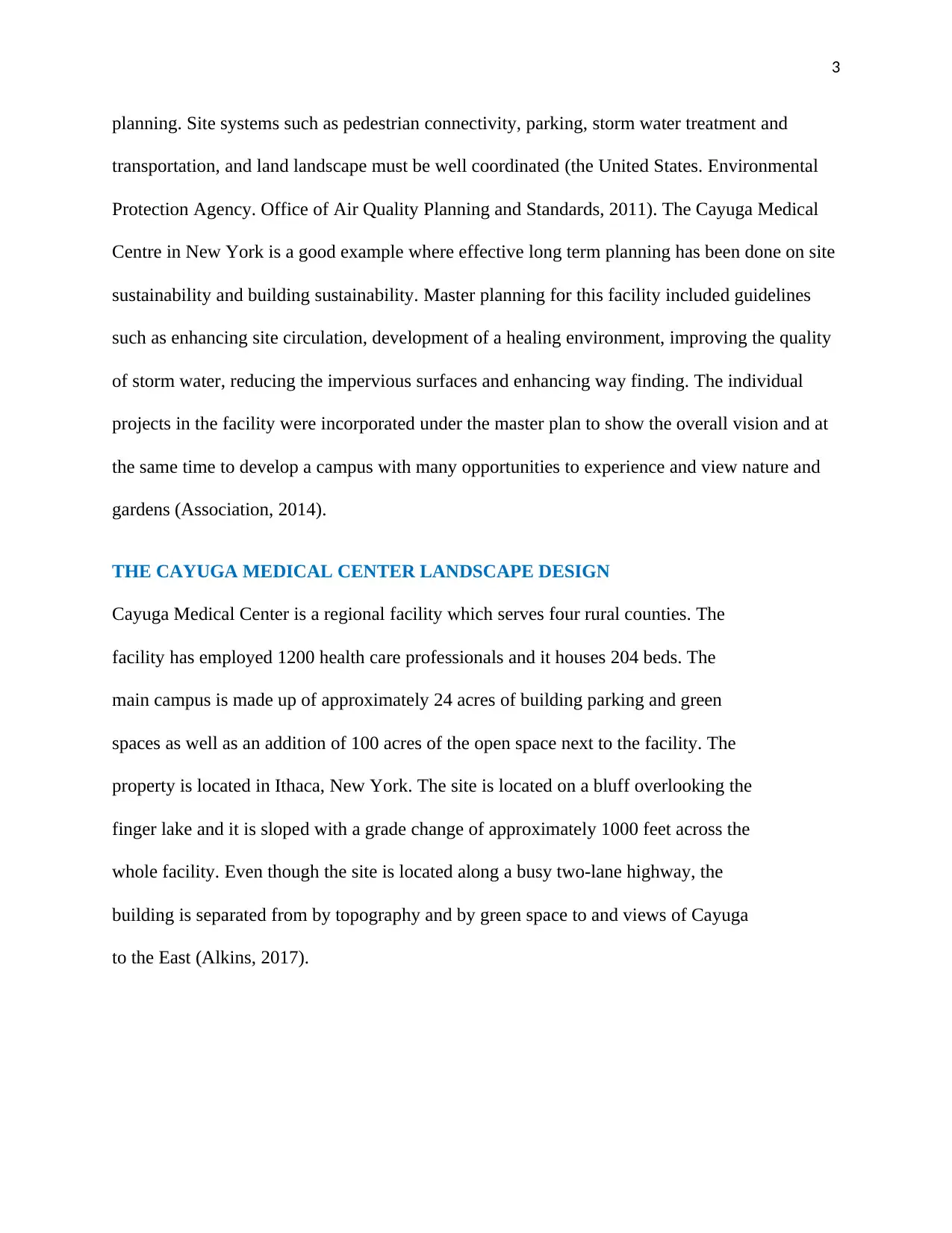
3
planning. Site systems such as pedestrian connectivity, parking, storm water treatment and
transportation, and land landscape must be well coordinated (the United States. Environmental
Protection Agency. Office of Air Quality Planning and Standards, 2011). The Cayuga Medical
Centre in New York is a good example where effective long term planning has been done on site
sustainability and building sustainability. Master planning for this facility included guidelines
such as enhancing site circulation, development of a healing environment, improving the quality
of storm water, reducing the impervious surfaces and enhancing way finding. The individual
projects in the facility were incorporated under the master plan to show the overall vision and at
the same time to develop a campus with many opportunities to experience and view nature and
gardens (Association, 2014).
THE CAYUGA MEDICAL CENTER LANDSCAPE DESIGN
Cayuga Medical Center is a regional facility which serves four rural counties. The
facility has employed 1200 health care professionals and it houses 204 beds. The
main campus is made up of approximately 24 acres of building parking and green
spaces as well as an addition of 100 acres of the open space next to the facility. The
property is located in Ithaca, New York. The site is located on a bluff overlooking the
finger lake and it is sloped with a grade change of approximately 1000 feet across the
whole facility. Even though the site is located along a busy two-lane highway, the
building is separated from by topography and by green space to and views of Cayuga
to the East (Alkins, 2017).
planning. Site systems such as pedestrian connectivity, parking, storm water treatment and
transportation, and land landscape must be well coordinated (the United States. Environmental
Protection Agency. Office of Air Quality Planning and Standards, 2011). The Cayuga Medical
Centre in New York is a good example where effective long term planning has been done on site
sustainability and building sustainability. Master planning for this facility included guidelines
such as enhancing site circulation, development of a healing environment, improving the quality
of storm water, reducing the impervious surfaces and enhancing way finding. The individual
projects in the facility were incorporated under the master plan to show the overall vision and at
the same time to develop a campus with many opportunities to experience and view nature and
gardens (Association, 2014).
THE CAYUGA MEDICAL CENTER LANDSCAPE DESIGN
Cayuga Medical Center is a regional facility which serves four rural counties. The
facility has employed 1200 health care professionals and it houses 204 beds. The
main campus is made up of approximately 24 acres of building parking and green
spaces as well as an addition of 100 acres of the open space next to the facility. The
property is located in Ithaca, New York. The site is located on a bluff overlooking the
finger lake and it is sloped with a grade change of approximately 1000 feet across the
whole facility. Even though the site is located along a busy two-lane highway, the
building is separated from by topography and by green space to and views of Cayuga
to the East (Alkins, 2017).
⊘ This is a preview!⊘
Do you want full access?
Subscribe today to unlock all pages.

Trusted by 1+ million students worldwide
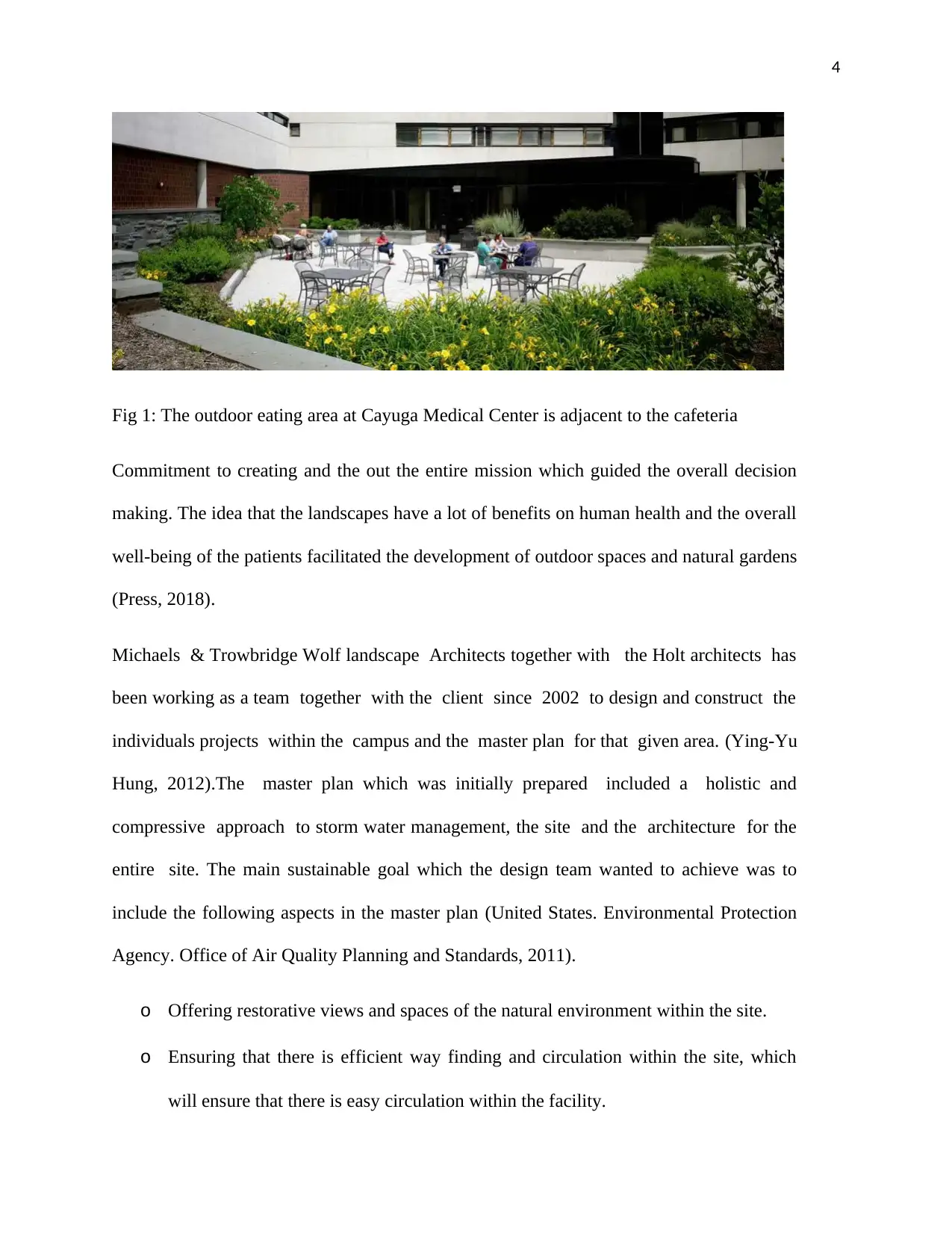
4
Fig 1: The outdoor eating area at Cayuga Medical Center is adjacent to the cafeteria
Commitment to creating and the out the entire mission which guided the overall decision
making. The idea that the landscapes have a lot of benefits on human health and the overall
well-being of the patients facilitated the development of outdoor spaces and natural gardens
(Press, 2018).
Michaels & Trowbridge Wolf landscape Architects together with the Holt architects has
been working as a team together with the client since 2002 to design and construct the
individuals projects within the campus and the master plan for that given area. (Ying-Yu
Hung, 2012).The master plan which was initially prepared included a holistic and
compressive approach to storm water management, the site and the architecture for the
entire site. The main sustainable goal which the design team wanted to achieve was to
include the following aspects in the master plan (United States. Environmental Protection
Agency. Office of Air Quality Planning and Standards, 2011).
o Offering restorative views and spaces of the natural environment within the site.
o Ensuring that there is efficient way finding and circulation within the site, which
will ensure that there is easy circulation within the facility.
Fig 1: The outdoor eating area at Cayuga Medical Center is adjacent to the cafeteria
Commitment to creating and the out the entire mission which guided the overall decision
making. The idea that the landscapes have a lot of benefits on human health and the overall
well-being of the patients facilitated the development of outdoor spaces and natural gardens
(Press, 2018).
Michaels & Trowbridge Wolf landscape Architects together with the Holt architects has
been working as a team together with the client since 2002 to design and construct the
individuals projects within the campus and the master plan for that given area. (Ying-Yu
Hung, 2012).The master plan which was initially prepared included a holistic and
compressive approach to storm water management, the site and the architecture for the
entire site. The main sustainable goal which the design team wanted to achieve was to
include the following aspects in the master plan (United States. Environmental Protection
Agency. Office of Air Quality Planning and Standards, 2011).
o Offering restorative views and spaces of the natural environment within the site.
o Ensuring that there is efficient way finding and circulation within the site, which
will ensure that there is easy circulation within the facility.
Paraphrase This Document
Need a fresh take? Get an instant paraphrase of this document with our AI Paraphraser
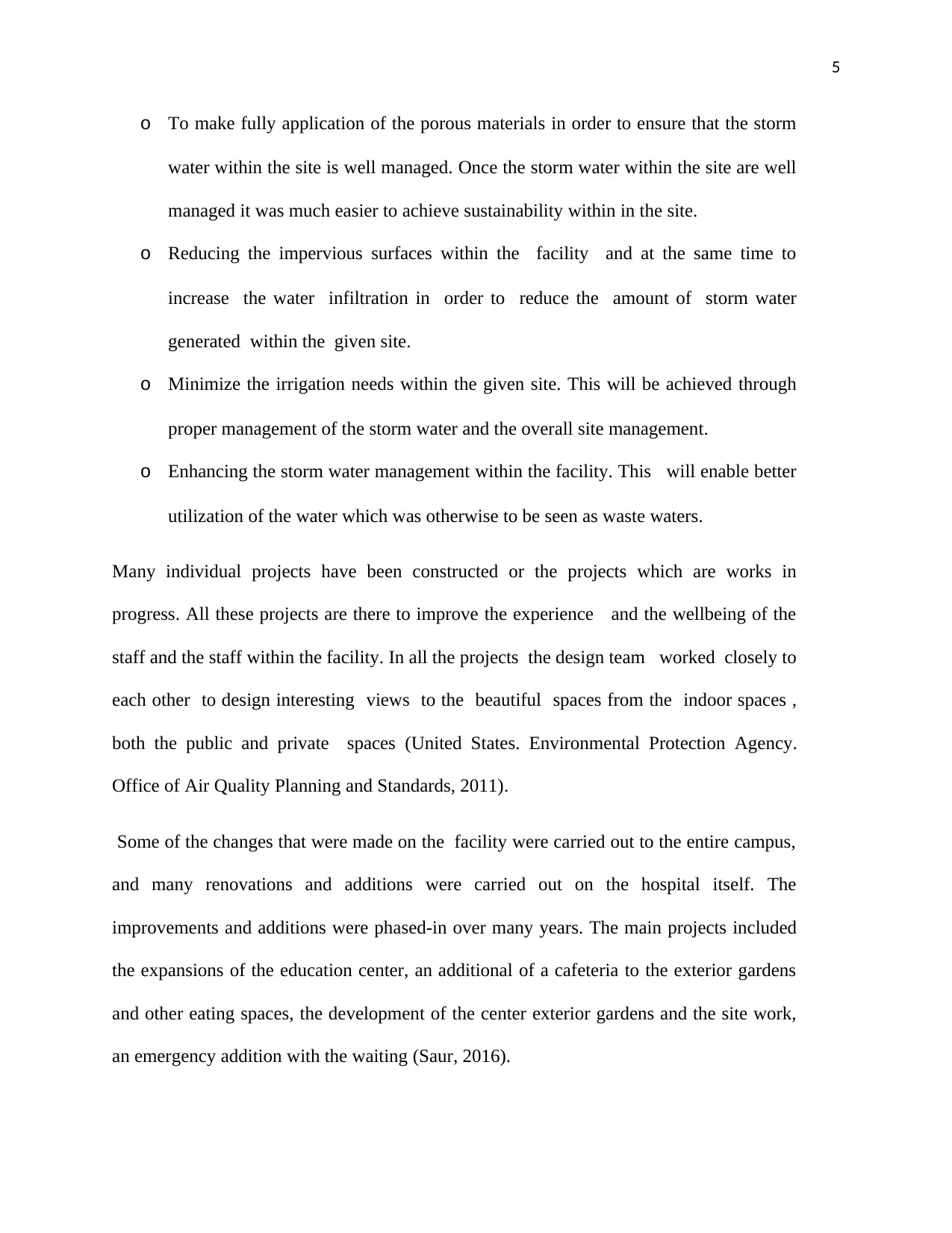
5
o To make fully application of the porous materials in order to ensure that the storm
water within the site is well managed. Once the storm water within the site are well
managed it was much easier to achieve sustainability within in the site.
o Reducing the impervious surfaces within the facility and at the same time to
increase the water infiltration in order to reduce the amount of storm water
generated within the given site.
o Minimize the irrigation needs within the given site. This will be achieved through
proper management of the storm water and the overall site management.
o Enhancing the storm water management within the facility. This will enable better
utilization of the water which was otherwise to be seen as waste waters.
Many individual projects have been constructed or the projects which are works in
progress. All these projects are there to improve the experience and the wellbeing of the
staff and the staff within the facility. In all the projects the design team worked closely to
each other to design interesting views to the beautiful spaces from the indoor spaces ,
both the public and private spaces (United States. Environmental Protection Agency.
Office of Air Quality Planning and Standards, 2011).
Some of the changes that were made on the facility were carried out to the entire campus,
and many renovations and additions were carried out on the hospital itself. The
improvements and additions were phased-in over many years. The main projects included
the expansions of the education center, an additional of a cafeteria to the exterior gardens
and other eating spaces, the development of the center exterior gardens and the site work,
an emergency addition with the waiting (Saur, 2016).
o To make fully application of the porous materials in order to ensure that the storm
water within the site is well managed. Once the storm water within the site are well
managed it was much easier to achieve sustainability within in the site.
o Reducing the impervious surfaces within the facility and at the same time to
increase the water infiltration in order to reduce the amount of storm water
generated within the given site.
o Minimize the irrigation needs within the given site. This will be achieved through
proper management of the storm water and the overall site management.
o Enhancing the storm water management within the facility. This will enable better
utilization of the water which was otherwise to be seen as waste waters.
Many individual projects have been constructed or the projects which are works in
progress. All these projects are there to improve the experience and the wellbeing of the
staff and the staff within the facility. In all the projects the design team worked closely to
each other to design interesting views to the beautiful spaces from the indoor spaces ,
both the public and private spaces (United States. Environmental Protection Agency.
Office of Air Quality Planning and Standards, 2011).
Some of the changes that were made on the facility were carried out to the entire campus,
and many renovations and additions were carried out on the hospital itself. The
improvements and additions were phased-in over many years. The main projects included
the expansions of the education center, an additional of a cafeteria to the exterior gardens
and other eating spaces, the development of the center exterior gardens and the site work,
an emergency addition with the waiting (Saur, 2016).
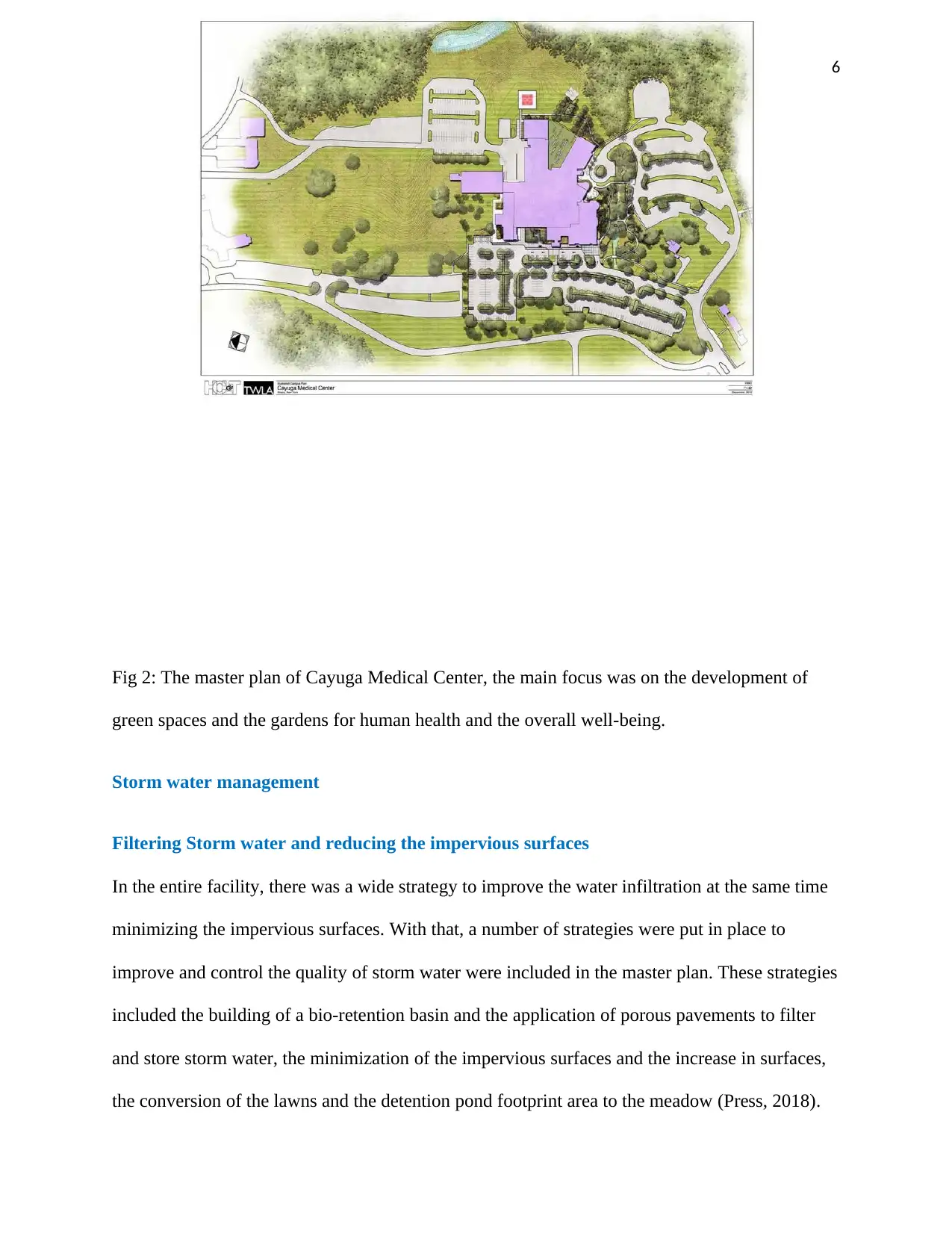
6
Fig 2: The master plan of Cayuga Medical Center, the main focus was on the development of
green spaces and the gardens for human health and the overall well-being.
Storm water management
Filtering Storm water and reducing the impervious surfaces
In the entire facility, there was a wide strategy to improve the water infiltration at the same time
minimizing the impervious surfaces. With that, a number of strategies were put in place to
improve and control the quality of storm water were included in the master plan. These strategies
included the building of a bio-retention basin and the application of porous pavements to filter
and store storm water, the minimization of the impervious surfaces and the increase in surfaces,
the conversion of the lawns and the detention pond footprint area to the meadow (Press, 2018).
Fig 2: The master plan of Cayuga Medical Center, the main focus was on the development of
green spaces and the gardens for human health and the overall well-being.
Storm water management
Filtering Storm water and reducing the impervious surfaces
In the entire facility, there was a wide strategy to improve the water infiltration at the same time
minimizing the impervious surfaces. With that, a number of strategies were put in place to
improve and control the quality of storm water were included in the master plan. These strategies
included the building of a bio-retention basin and the application of porous pavements to filter
and store storm water, the minimization of the impervious surfaces and the increase in surfaces,
the conversion of the lawns and the detention pond footprint area to the meadow (Press, 2018).
⊘ This is a preview!⊘
Do you want full access?
Subscribe today to unlock all pages.

Trusted by 1+ million students worldwide
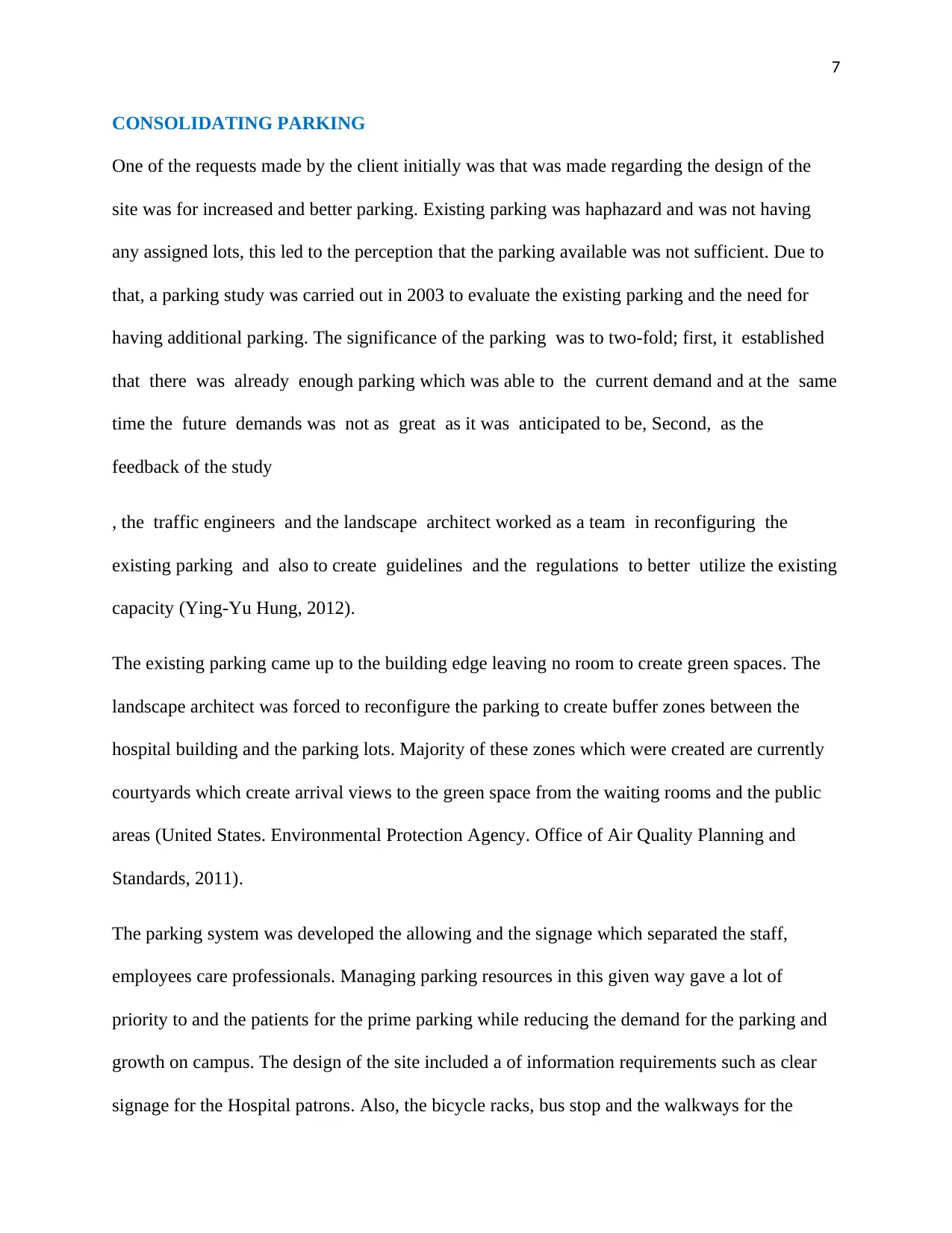
7
CONSOLIDATING PARKING
One of the requests made by the client initially was that was made regarding the design of the
site was for increased and better parking. Existing parking was haphazard and was not having
any assigned lots, this led to the perception that the parking available was not sufficient. Due to
that, a parking study was carried out in 2003 to evaluate the existing parking and the need for
having additional parking. The significance of the parking was to two-fold; first, it established
that there was already enough parking which was able to the current demand and at the same
time the future demands was not as great as it was anticipated to be, Second, as the
feedback of the study
, the traffic engineers and the landscape architect worked as a team in reconfiguring the
existing parking and also to create guidelines and the regulations to better utilize the existing
capacity (Ying-Yu Hung, 2012).
The existing parking came up to the building edge leaving no room to create green spaces. The
landscape architect was forced to reconfigure the parking to create buffer zones between the
hospital building and the parking lots. Majority of these zones which were created are currently
courtyards which create arrival views to the green space from the waiting rooms and the public
areas (United States. Environmental Protection Agency. Office of Air Quality Planning and
Standards, 2011).
The parking system was developed the allowing and the signage which separated the staff,
employees care professionals. Managing parking resources in this given way gave a lot of
priority to and the patients for the prime parking while reducing the demand for the parking and
growth on campus. The design of the site included a of information requirements such as clear
signage for the Hospital patrons. Also, the bicycle racks, bus stop and the walkways for the
CONSOLIDATING PARKING
One of the requests made by the client initially was that was made regarding the design of the
site was for increased and better parking. Existing parking was haphazard and was not having
any assigned lots, this led to the perception that the parking available was not sufficient. Due to
that, a parking study was carried out in 2003 to evaluate the existing parking and the need for
having additional parking. The significance of the parking was to two-fold; first, it established
that there was already enough parking which was able to the current demand and at the same
time the future demands was not as great as it was anticipated to be, Second, as the
feedback of the study
, the traffic engineers and the landscape architect worked as a team in reconfiguring the
existing parking and also to create guidelines and the regulations to better utilize the existing
capacity (Ying-Yu Hung, 2012).
The existing parking came up to the building edge leaving no room to create green spaces. The
landscape architect was forced to reconfigure the parking to create buffer zones between the
hospital building and the parking lots. Majority of these zones which were created are currently
courtyards which create arrival views to the green space from the waiting rooms and the public
areas (United States. Environmental Protection Agency. Office of Air Quality Planning and
Standards, 2011).
The parking system was developed the allowing and the signage which separated the staff,
employees care professionals. Managing parking resources in this given way gave a lot of
priority to and the patients for the prime parking while reducing the demand for the parking and
growth on campus. The design of the site included a of information requirements such as clear
signage for the Hospital patrons. Also, the bicycle racks, bus stop and the walkways for the
Paraphrase This Document
Need a fresh take? Get an instant paraphrase of this document with our AI Paraphraser
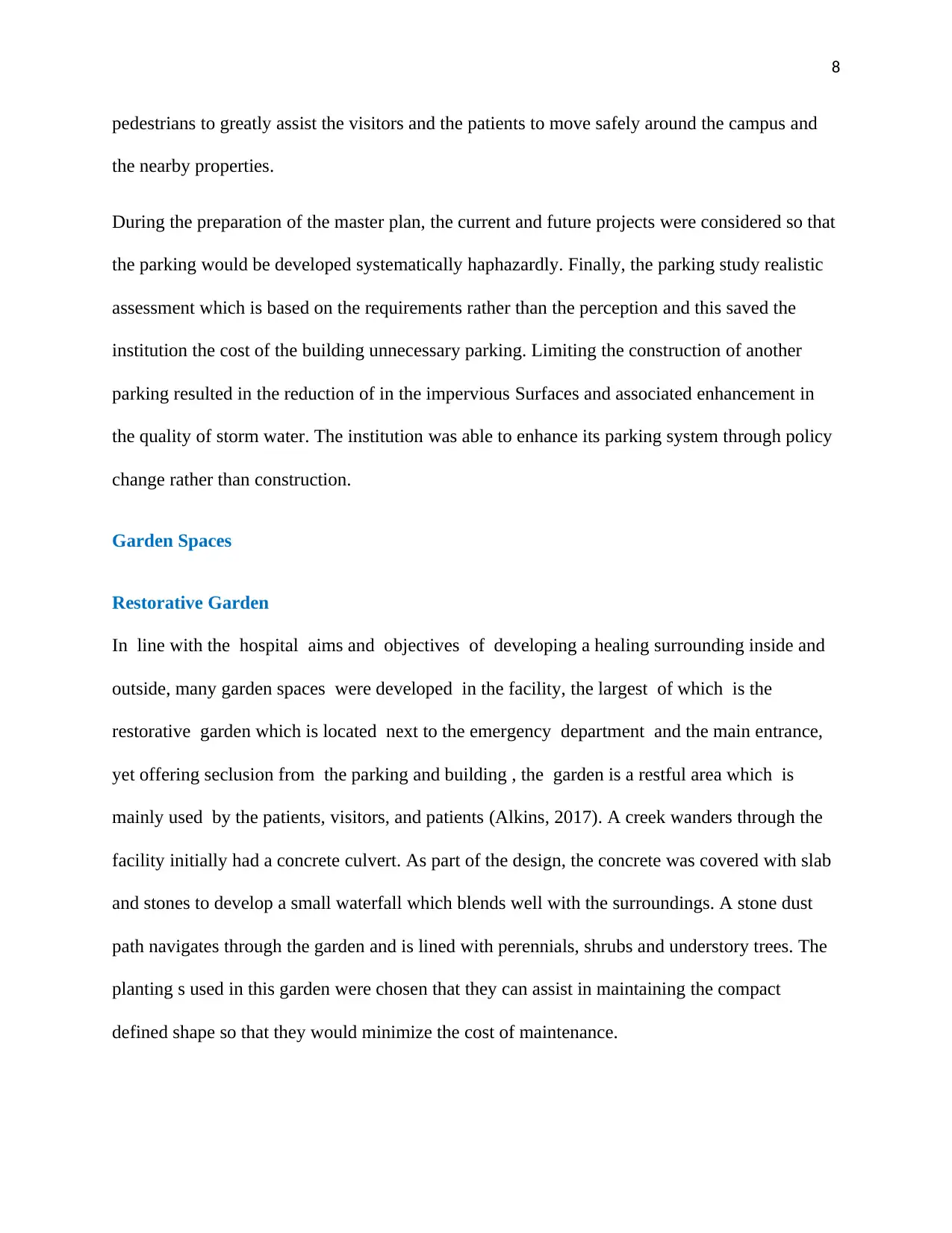
8
pedestrians to greatly assist the visitors and the patients to move safely around the campus and
the nearby properties.
During the preparation of the master plan, the current and future projects were considered so that
the parking would be developed systematically haphazardly. Finally, the parking study realistic
assessment which is based on the requirements rather than the perception and this saved the
institution the cost of the building unnecessary parking. Limiting the construction of another
parking resulted in the reduction of in the impervious Surfaces and associated enhancement in
the quality of storm water. The institution was able to enhance its parking system through policy
change rather than construction.
Garden Spaces
Restorative Garden
In line with the hospital aims and objectives of developing a healing surrounding inside and
outside, many garden spaces were developed in the facility, the largest of which is the
restorative garden which is located next to the emergency department and the main entrance,
yet offering seclusion from the parking and building , the garden is a restful area which is
mainly used by the patients, visitors, and patients (Alkins, 2017). A creek wanders through the
facility initially had a concrete culvert. As part of the design, the concrete was covered with slab
and stones to develop a small waterfall which blends well with the surroundings. A stone dust
path navigates through the garden and is lined with perennials, shrubs and understory trees. The
planting s used in this garden were chosen that they can assist in maintaining the compact
defined shape so that they would minimize the cost of maintenance.
pedestrians to greatly assist the visitors and the patients to move safely around the campus and
the nearby properties.
During the preparation of the master plan, the current and future projects were considered so that
the parking would be developed systematically haphazardly. Finally, the parking study realistic
assessment which is based on the requirements rather than the perception and this saved the
institution the cost of the building unnecessary parking. Limiting the construction of another
parking resulted in the reduction of in the impervious Surfaces and associated enhancement in
the quality of storm water. The institution was able to enhance its parking system through policy
change rather than construction.
Garden Spaces
Restorative Garden
In line with the hospital aims and objectives of developing a healing surrounding inside and
outside, many garden spaces were developed in the facility, the largest of which is the
restorative garden which is located next to the emergency department and the main entrance,
yet offering seclusion from the parking and building , the garden is a restful area which is
mainly used by the patients, visitors, and patients (Alkins, 2017). A creek wanders through the
facility initially had a concrete culvert. As part of the design, the concrete was covered with slab
and stones to develop a small waterfall which blends well with the surroundings. A stone dust
path navigates through the garden and is lined with perennials, shrubs and understory trees. The
planting s used in this garden were chosen that they can assist in maintaining the compact
defined shape so that they would minimize the cost of maintenance.
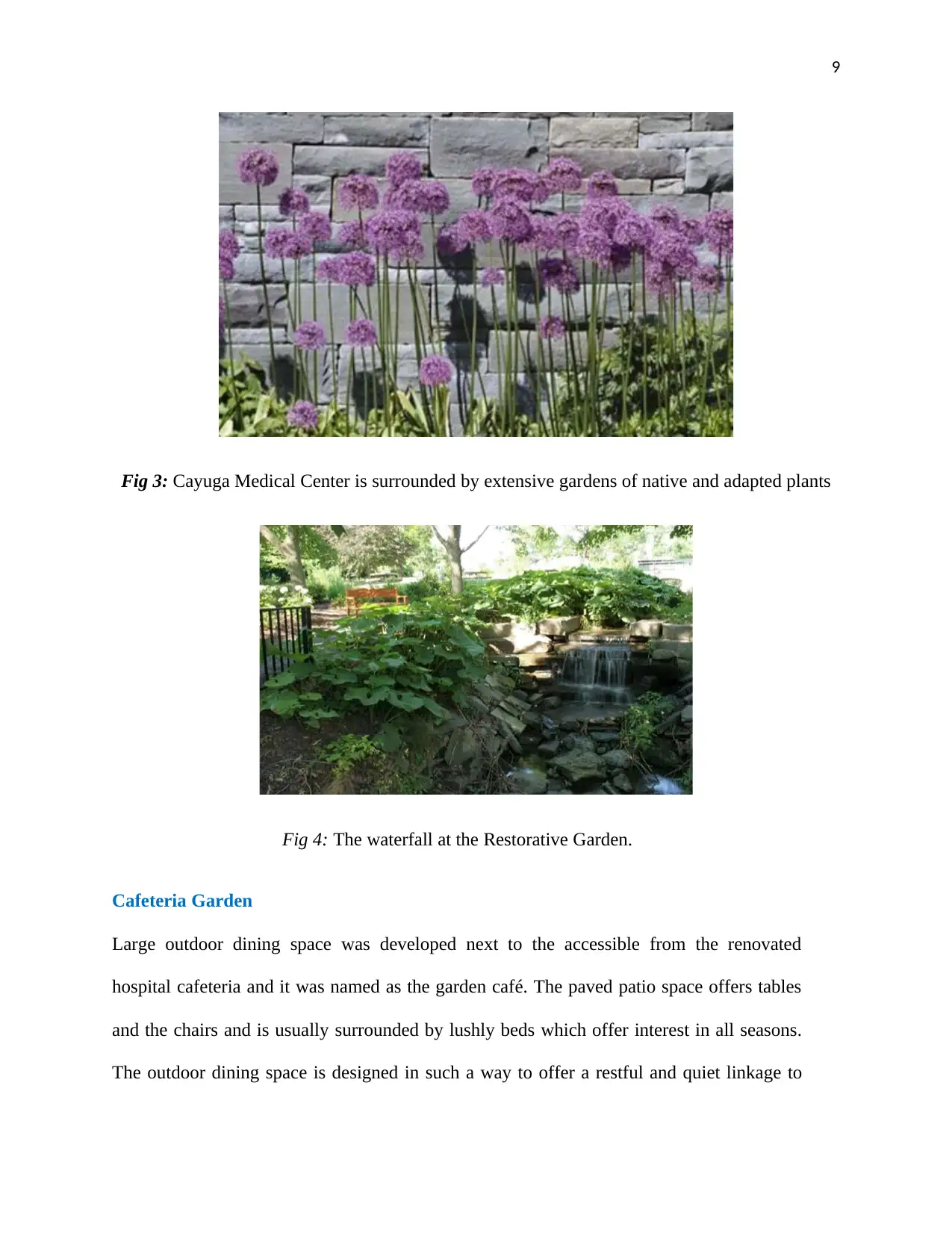
9
Fig 3: Cayuga Medical Center is surrounded by extensive gardens of native and adapted plants
Fig 4: The waterfall at the Restorative Garden.
Cafeteria Garden
Large outdoor dining space was developed next to the accessible from the renovated
hospital cafeteria and it was named as the garden café. The paved patio space offers tables
and the chairs and is usually surrounded by lushly beds which offer interest in all seasons.
The outdoor dining space is designed in such a way to offer a restful and quiet linkage to
Fig 3: Cayuga Medical Center is surrounded by extensive gardens of native and adapted plants
Fig 4: The waterfall at the Restorative Garden.
Cafeteria Garden
Large outdoor dining space was developed next to the accessible from the renovated
hospital cafeteria and it was named as the garden café. The paved patio space offers tables
and the chairs and is usually surrounded by lushly beds which offer interest in all seasons.
The outdoor dining space is designed in such a way to offer a restful and quiet linkage to
⊘ This is a preview!⊘
Do you want full access?
Subscribe today to unlock all pages.

Trusted by 1+ million students worldwide
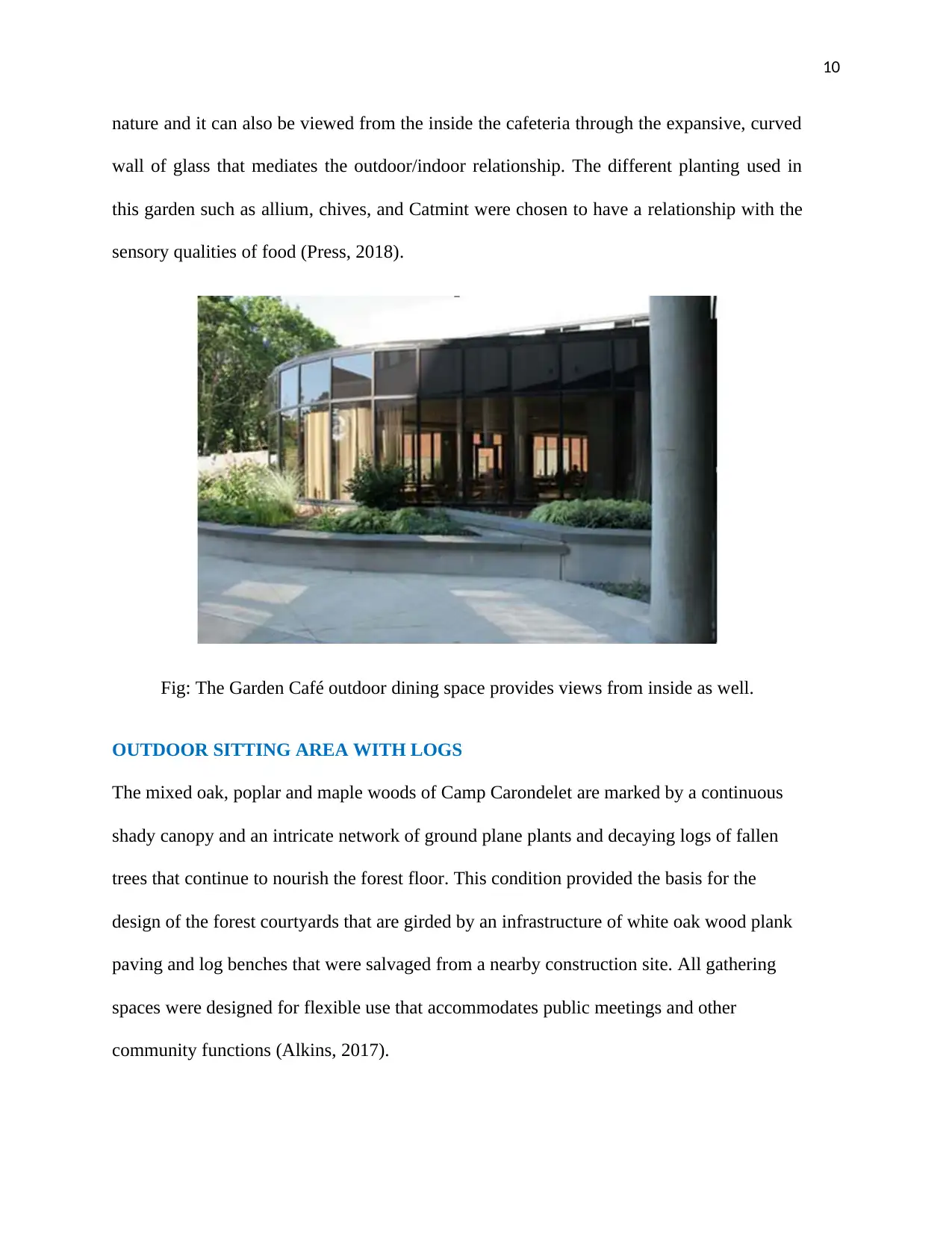
10
nature and it can also be viewed from the inside the cafeteria through the expansive, curved
wall of glass that mediates the outdoor/indoor relationship. The different planting used in
this garden such as allium, chives, and Catmint were chosen to have a relationship with the
sensory qualities of food (Press, 2018).
Fig: The Garden Café outdoor dining space provides views from inside as well.
OUTDOOR SITTING AREA WITH LOGS
The mixed oak, poplar and maple woods of Camp Carondelet are marked by a continuous
shady canopy and an intricate network of ground plane plants and decaying logs of fallen
trees that continue to nourish the forest floor. This condition provided the basis for the
design of the forest courtyards that are girded by an infrastructure of white oak wood plank
paving and log benches that were salvaged from a nearby construction site. All gathering
spaces were designed for flexible use that accommodates public meetings and other
community functions (Alkins, 2017).
nature and it can also be viewed from the inside the cafeteria through the expansive, curved
wall of glass that mediates the outdoor/indoor relationship. The different planting used in
this garden such as allium, chives, and Catmint were chosen to have a relationship with the
sensory qualities of food (Press, 2018).
Fig: The Garden Café outdoor dining space provides views from inside as well.
OUTDOOR SITTING AREA WITH LOGS
The mixed oak, poplar and maple woods of Camp Carondelet are marked by a continuous
shady canopy and an intricate network of ground plane plants and decaying logs of fallen
trees that continue to nourish the forest floor. This condition provided the basis for the
design of the forest courtyards that are girded by an infrastructure of white oak wood plank
paving and log benches that were salvaged from a nearby construction site. All gathering
spaces were designed for flexible use that accommodates public meetings and other
community functions (Alkins, 2017).
Paraphrase This Document
Need a fresh take? Get an instant paraphrase of this document with our AI Paraphraser
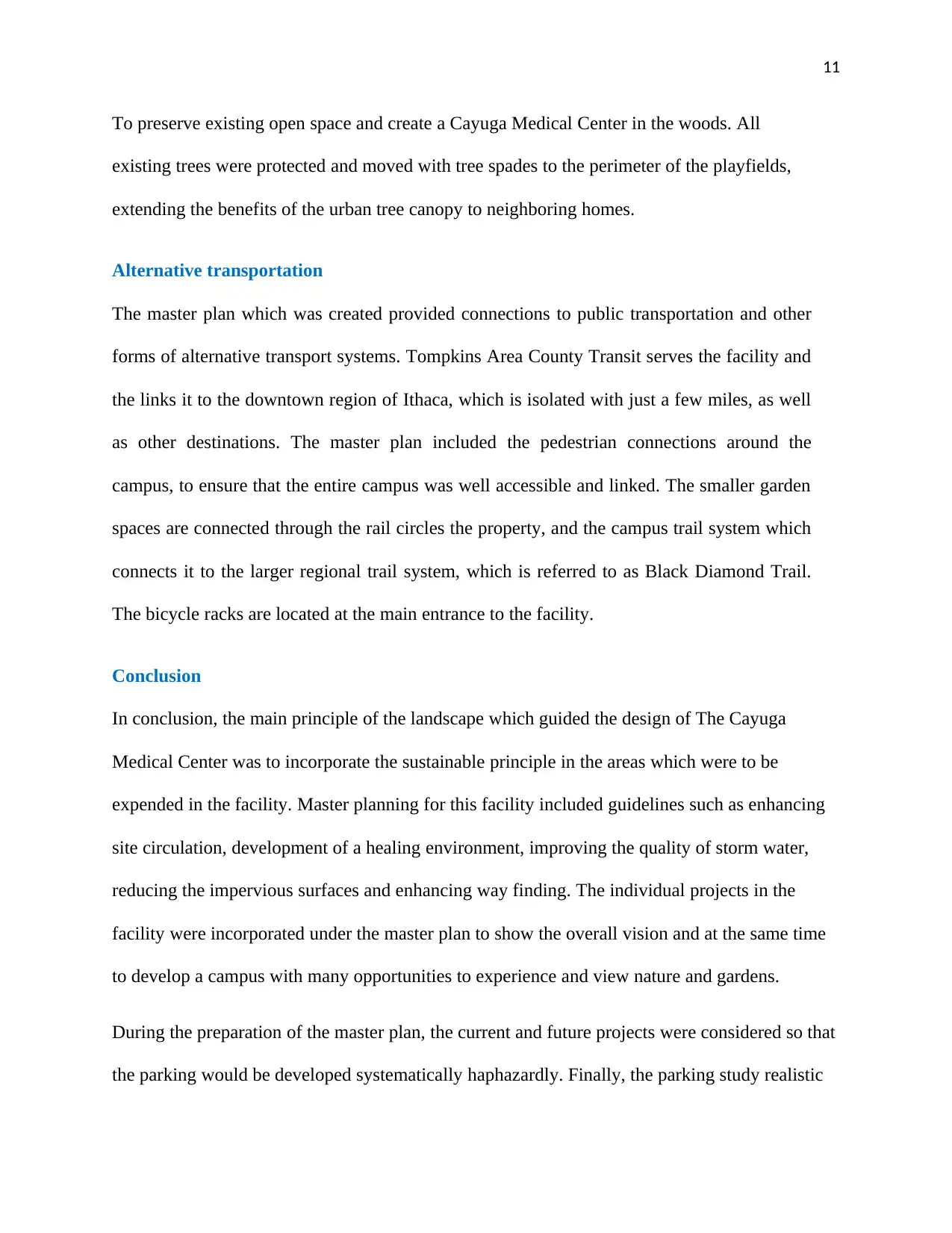
11
To preserve existing open space and create a Cayuga Medical Center in the woods. All
existing trees were protected and moved with tree spades to the perimeter of the playfields,
extending the benefits of the urban tree canopy to neighboring homes.
Alternative transportation
The master plan which was created provided connections to public transportation and other
forms of alternative transport systems. Tompkins Area County Transit serves the facility and
the links it to the downtown region of Ithaca, which is isolated with just a few miles, as well
as other destinations. The master plan included the pedestrian connections around the
campus, to ensure that the entire campus was well accessible and linked. The smaller garden
spaces are connected through the rail circles the property, and the campus trail system which
connects it to the larger regional trail system, which is referred to as Black Diamond Trail.
The bicycle racks are located at the main entrance to the facility.
Conclusion
In conclusion, the main principle of the landscape which guided the design of The Cayuga
Medical Center was to incorporate the sustainable principle in the areas which were to be
expended in the facility. Master planning for this facility included guidelines such as enhancing
site circulation, development of a healing environment, improving the quality of storm water,
reducing the impervious surfaces and enhancing way finding. The individual projects in the
facility were incorporated under the master plan to show the overall vision and at the same time
to develop a campus with many opportunities to experience and view nature and gardens.
During the preparation of the master plan, the current and future projects were considered so that
the parking would be developed systematically haphazardly. Finally, the parking study realistic
To preserve existing open space and create a Cayuga Medical Center in the woods. All
existing trees were protected and moved with tree spades to the perimeter of the playfields,
extending the benefits of the urban tree canopy to neighboring homes.
Alternative transportation
The master plan which was created provided connections to public transportation and other
forms of alternative transport systems. Tompkins Area County Transit serves the facility and
the links it to the downtown region of Ithaca, which is isolated with just a few miles, as well
as other destinations. The master plan included the pedestrian connections around the
campus, to ensure that the entire campus was well accessible and linked. The smaller garden
spaces are connected through the rail circles the property, and the campus trail system which
connects it to the larger regional trail system, which is referred to as Black Diamond Trail.
The bicycle racks are located at the main entrance to the facility.
Conclusion
In conclusion, the main principle of the landscape which guided the design of The Cayuga
Medical Center was to incorporate the sustainable principle in the areas which were to be
expended in the facility. Master planning for this facility included guidelines such as enhancing
site circulation, development of a healing environment, improving the quality of storm water,
reducing the impervious surfaces and enhancing way finding. The individual projects in the
facility were incorporated under the master plan to show the overall vision and at the same time
to develop a campus with many opportunities to experience and view nature and gardens.
During the preparation of the master plan, the current and future projects were considered so that
the parking would be developed systematically haphazardly. Finally, the parking study realistic
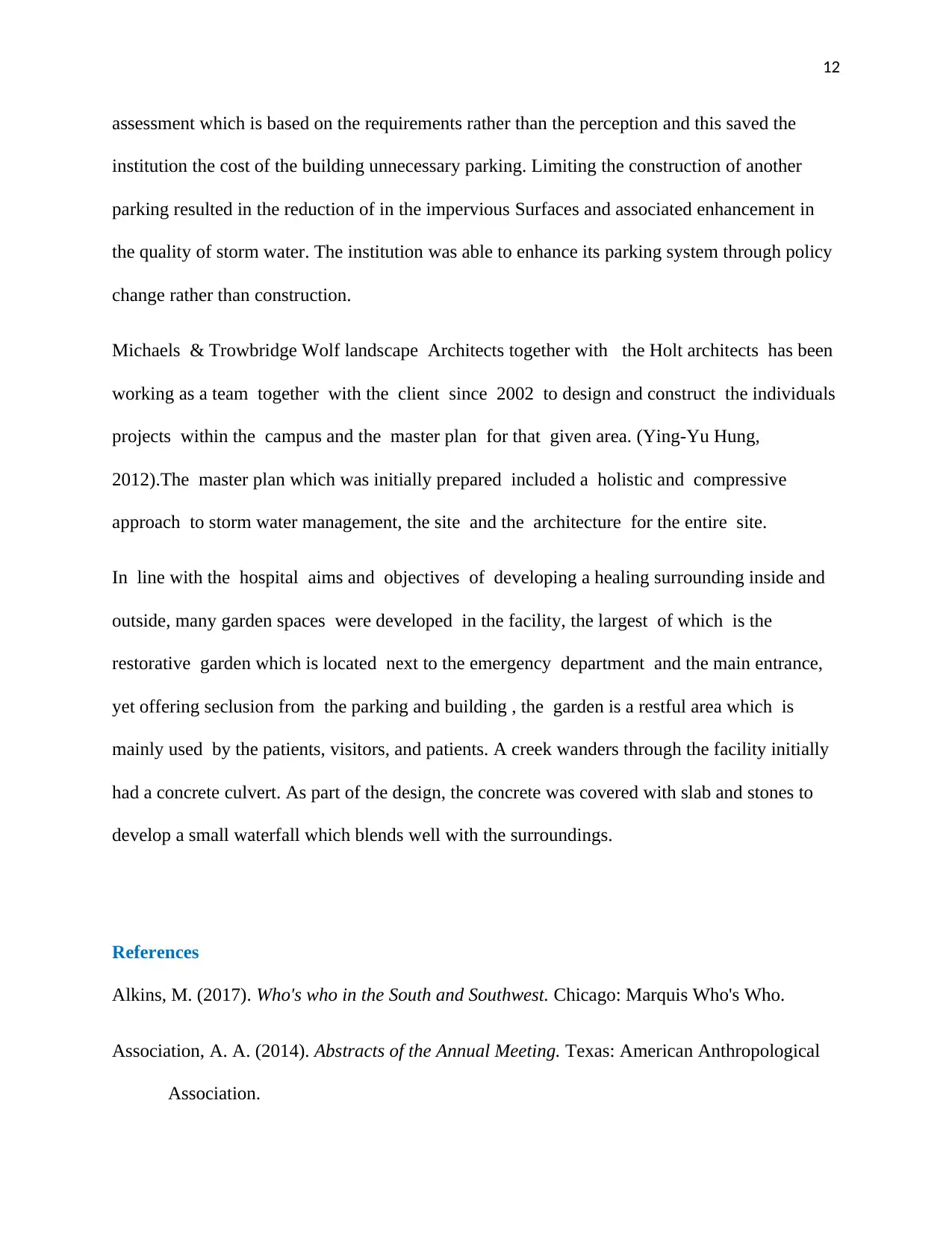
12
assessment which is based on the requirements rather than the perception and this saved the
institution the cost of the building unnecessary parking. Limiting the construction of another
parking resulted in the reduction of in the impervious Surfaces and associated enhancement in
the quality of storm water. The institution was able to enhance its parking system through policy
change rather than construction.
Michaels & Trowbridge Wolf landscape Architects together with the Holt architects has been
working as a team together with the client since 2002 to design and construct the individuals
projects within the campus and the master plan for that given area. (Ying-Yu Hung,
2012).The master plan which was initially prepared included a holistic and compressive
approach to storm water management, the site and the architecture for the entire site.
In line with the hospital aims and objectives of developing a healing surrounding inside and
outside, many garden spaces were developed in the facility, the largest of which is the
restorative garden which is located next to the emergency department and the main entrance,
yet offering seclusion from the parking and building , the garden is a restful area which is
mainly used by the patients, visitors, and patients. A creek wanders through the facility initially
had a concrete culvert. As part of the design, the concrete was covered with slab and stones to
develop a small waterfall which blends well with the surroundings.
References
Alkins, M. (2017). Who's who in the South and Southwest. Chicago: Marquis Who's Who.
Association, A. A. (2014). Abstracts of the Annual Meeting. Texas: American Anthropological
Association.
assessment which is based on the requirements rather than the perception and this saved the
institution the cost of the building unnecessary parking. Limiting the construction of another
parking resulted in the reduction of in the impervious Surfaces and associated enhancement in
the quality of storm water. The institution was able to enhance its parking system through policy
change rather than construction.
Michaels & Trowbridge Wolf landscape Architects together with the Holt architects has been
working as a team together with the client since 2002 to design and construct the individuals
projects within the campus and the master plan for that given area. (Ying-Yu Hung,
2012).The master plan which was initially prepared included a holistic and compressive
approach to storm water management, the site and the architecture for the entire site.
In line with the hospital aims and objectives of developing a healing surrounding inside and
outside, many garden spaces were developed in the facility, the largest of which is the
restorative garden which is located next to the emergency department and the main entrance,
yet offering seclusion from the parking and building , the garden is a restful area which is
mainly used by the patients, visitors, and patients. A creek wanders through the facility initially
had a concrete culvert. As part of the design, the concrete was covered with slab and stones to
develop a small waterfall which blends well with the surroundings.
References
Alkins, M. (2017). Who's who in the South and Southwest. Chicago: Marquis Who's Who.
Association, A. A. (2014). Abstracts of the Annual Meeting. Texas: American Anthropological
Association.
⊘ This is a preview!⊘
Do you want full access?
Subscribe today to unlock all pages.

Trusted by 1+ million students worldwide
1 out of 14
Your All-in-One AI-Powered Toolkit for Academic Success.
+13062052269
info@desklib.com
Available 24*7 on WhatsApp / Email
![[object Object]](/_next/static/media/star-bottom.7253800d.svg)
Unlock your academic potential
Copyright © 2020–2025 A2Z Services. All Rights Reserved. Developed and managed by ZUCOL.

